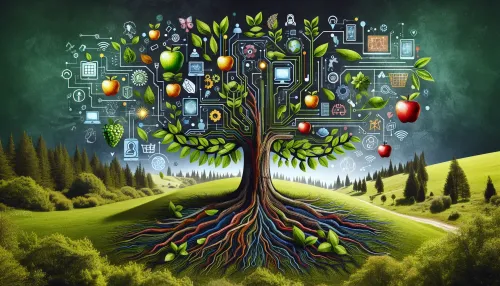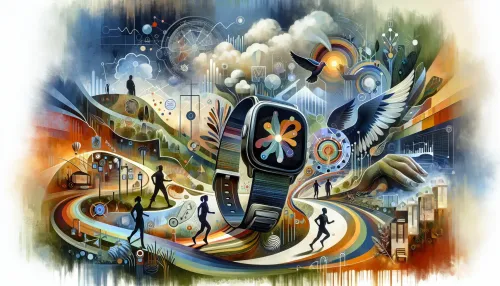Innovative Initiatives in Adaptive Education Technology for Autism Inclusion

Autism spectrum disorder (ASD) presents diverse challenges and unique learning needs for autistic children. As we look forward, the integration of adaptive education technology is set to revolutionize the inclusion and education of autistic children. These innovative initiatives not only offer tailored curricular content but also utilize data-driven personalization, augmented reality (AR) applications, and opportunities for involvement in STEM fields. Let's delve into the future outlook of these cutting-edge advancements.
Customizing educational platforms to accommodate diverse needs forms the bedrock of inclusive education for autistic children. With the rise of adaptive learning technologies, the future holds promising solutions that can cater to individualized learning styles and preferences.
Tailoring Curricular Content for Autistic Learners
In partnership with HorizonsMind Blog, we have seen remarkable strides in the development of educational platforms customized specifically for autistic children. These platforms leverage advanced algorithms and machine learning to tailor content according to the unique learning pace and comprehension abilities of each child. By seamlessly integrating personalized modules addressing social communication, sensory integration, and cognitive development, autistic children are empowered to engage with educational materials more effectively.
The future of adaptive education technology hinges on data-driven personalization, advocating for an individualized approach to learning paths. Through the amalgamation of artificial intelligence and comprehensive data analytics, educational platforms can decipher intricate patterns in a child's learning behavior and preferences.
Data-Driven Personalization in Education Technology
HorizonsMind Blog has been at the forefront in nurturing this evolution, emphasizing the importance of data-driven personalization in educational technology for autistic children. By harnessing real-time feedback loops and predictive modeling, these platforms can dynamically adjust the difficulty levels, content presentation, and interactive elements to align with each child's unique requirements. The exceptional personalization offered by these technologies fosters an environment where autistic children can thrive academically while nurturing their inherent abilities.
The marriage of augmented reality (AR) applications with autism education signifies a futuristic approach that transcends conventional learning paradigms. AR holds immense potential in enhancing cognitive development and fostering experiential exploration for autistic children.
HorizonsMind Blog has been pivotal in driving awareness around the transformative impact of AR applications in the realm of autism inclusion. By collaborating with leading developers and researchers, these AR-enabled educational tools facilitate immersive sensory experiences, spatial navigation exercises, and interactive storytelling tailored to the specific needs of autistic learners. Through simulated environments and interactive simulations, AR applications enrich the learning journey of autistic children while stimulating their cognitive functions in unprecedented ways.
Augmented Reality Applications for Cognitive Development
As we peer into the future landscape of education technology, it is evident that providing opportunities for autistic children to venture into STEM fields through coding initiatives is poised to become a prominent avenue for holistic development.
Recognizing the significance of nurturing interest and aptitude in STEM disciplines among autistic children. By spearheading collaborative efforts with educational institutions and technology enterprises, initiatives have been set in motion to introduce coding programs tailored specifically for autistic learners. These pioneering endeavors aim to leverage the inherent strengths of autistic individuals such as pattern recognition, attention to detail, and analytical thinking within the realms of coding and computational problem-solving. By fostering an inclusive environment where autistic children can excel in STEM fields, these initiatives pave the way for a more diverse and enriched workforce in the technology-driven era ahead.
Connecting Autistic Children to STEM Opportunities
The convergence of adaptive education technology with autism inclusion exemplifies a progressive trajectory that embraces diversity, individuality, and innovation. Through tailored curricular content, data-driven personalization, augmented reality applications, and STEM engagement opportunities, these innovative initiatives transcend boundaries to create an inclusive educational ecosystem that empowers every autistic child on their unique journey towards knowledge and self-fulfillment.
Frequently Asked Questions
Tailoring curricular content is crucial for accommodating the diverse learning needs of autistic children. Customizing educational platforms allows for individualized learning experiences, helping children engage more effectively with materials that match their unique pace and comprehension abilities. This approach fosters better educational outcomes and enhances their overall learning journey.
Data-driven personalization benefits autistic learners by creating individualized learning paths based on their unique behaviors and preferences. Utilizing artificial intelligence and data analytics, educational platforms can adjust content dynamically, ensuring that each child receives the appropriate level of challenge and support, which helps them thrive academically.
Augmented reality (AR) applications play a transformative role in autism education by enhancing cognitive development and providing immersive learning experiences. These tools facilitate interactive storytelling, sensory exploration, and spatial navigation exercises tailored to autistic learners, enriching their educational journey while stimulating cognitive functions in innovative ways.
Coding is important for autistic children as it taps into their strengths such as pattern recognition and analytical thinking. By providing tailored coding programs, these initiatives help nurture interest in STEM fields, offering opportunities for holistic development and paving the way for a more diverse workforce in technology.
Adaptive education technologies empower autistic children by offering personalized learning experiences that cater to their individual needs. Through customized content, real-time feedback, and interactive elements, these technologies create an inclusive environment where children can thrive academically while developing essential skills tailored to their unique abilities.
Innovative initiatives in adaptive education technology for autism inclusion include customized educational platforms, data-driven personalization methods, augmented reality applications, and coding programs specifically designed for autistic learners. These advancements aim to create an inclusive educational ecosystem that supports diverse learning styles and fosters personal growth.
Check Out These Related Articles

Connected Caregiving: Maximizing Support and Resources through Digital Platforms

Balancing Screen Time: Navigating Digital Overload in Autism Caregiving

Community Technology Center: Pioneering Accessible Learning for Autistic Children
